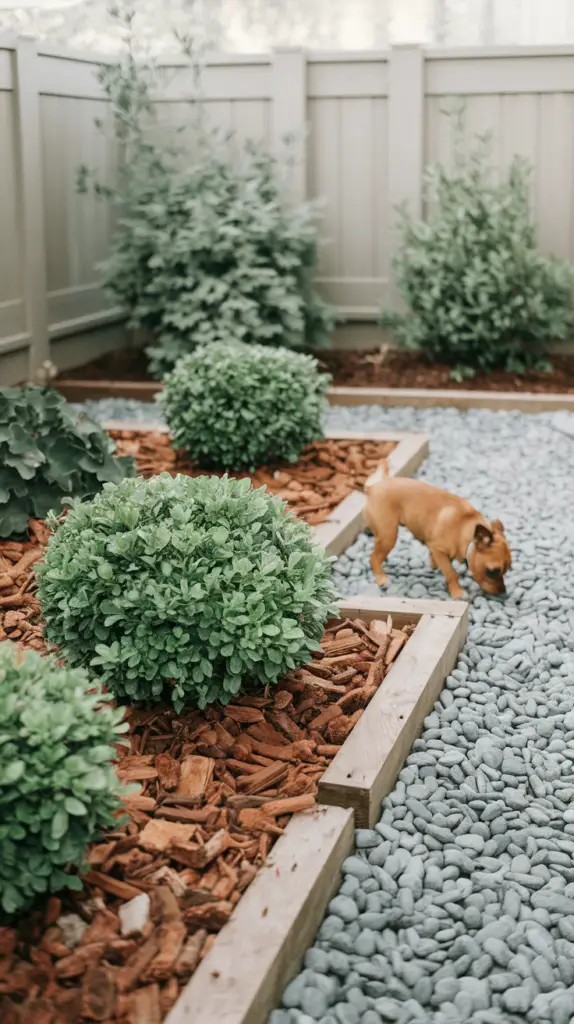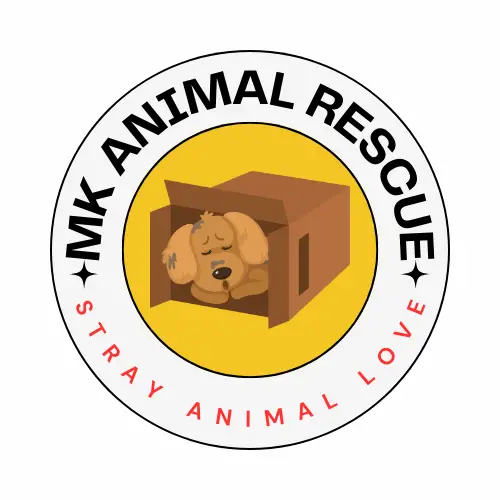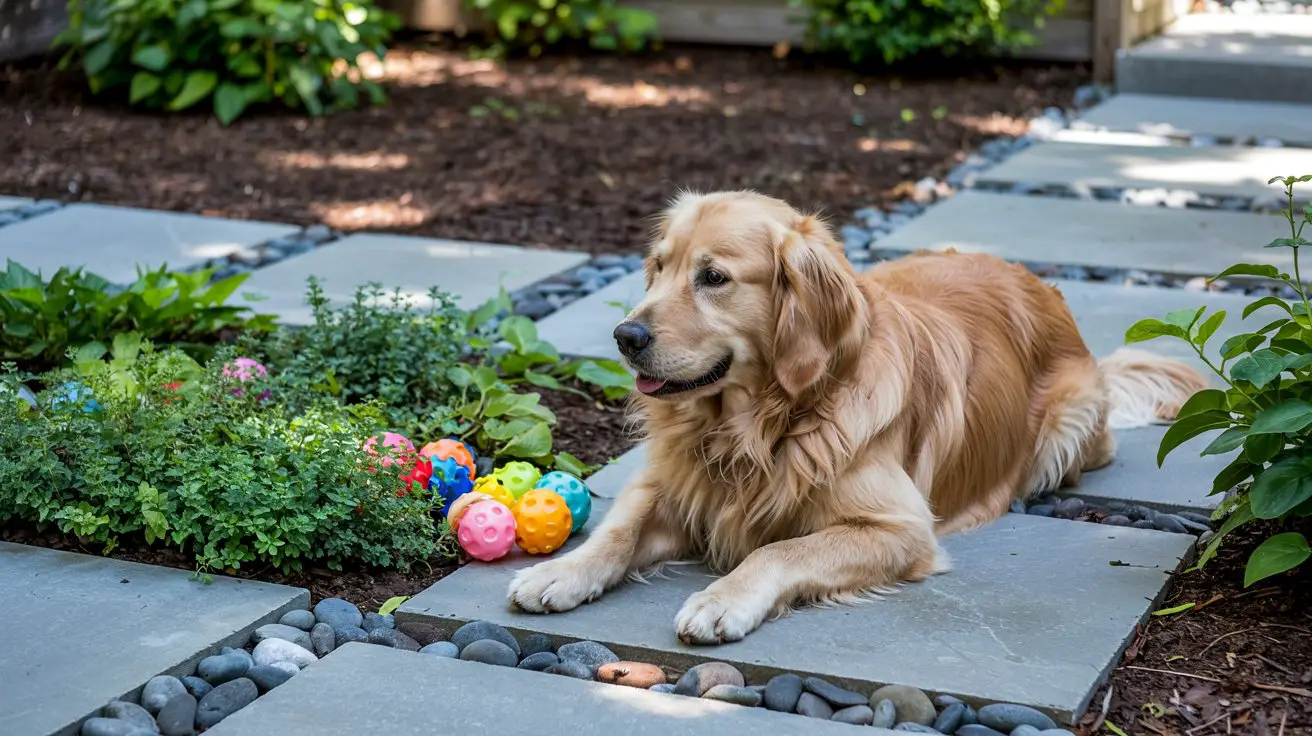
The day my dog figured out how to dig under the garden gate was the same day I realized we needed a backyard plan.Like, yesterday. I’d spent weeks potting plants, stringing fairy lights, and making the patio look “intentional”—and within ten minutes, he’d turned it into a dig site and tried to chase a bird through the hedge. So yeah, this one’s personal.
Dog-proofing a backyard doesn’t mean turning it into a dog park or building a fortress. Honestly, it’s more about figuring out what your dog loves to do (dig? nap? sniff everything?) and giving them their own corner of joy while still keeping the space cute. It’s 100% possible to have a backyard that looks nice and doesn’t stress you out every time you let them out for a wee.
Create a Dog Run Using the Side Yard You Forgot Existed

We had this awkward side yard between the house and the fence—too narrow for furniture, too shady for real grass, and basically just a corridor for lost tennis balls. But with a bit of gravel, some stepping stones, and a simple mesh fence, it became the perfect little dog run. Now it’s my dog’s private zoomie lane, and I get to keep the main garden a little calmer.
A dog run works best when it feels like a mini trail—add a few potted shrubs, a stretch of faux turf, or even a bench if you want to sit and supervise. If your pup loves to patrol or just needs to get their energy out, this setup is a game-changer. It’s also great if you’re working on training and want a designated potty or play zone. Cheap, clean, and kind of adorable when you throw in a little name sign.
Use Decorative Gravel or Mulch That’s Safe for Paws

I used to have flower beds with bark mulch that looked amazing—until my dog decided it was all one big chew toy. Now I go for dog-safe gravel or cedar mulch that still gives that tidy, landscaped look without becoming a snack. Lay it around trees or garden borders, or use it to create paths through your yard where grass won’t grow anyway.
If you want to keep it stylish, try mixing textures—stone around the patio, cedar chips near the flower beds, and smooth pavers leading from the deck to the gate. It keeps muddy paws at bay and honestly makes the yard feel more finished. Just make sure to avoid cocoa mulch or anything sharp (some decorative rocks are sneaky like that). I like using warm-colored gravel—it blends in with the wood fence and doesn’t scream “dog zone.”
Add a Fenced-Off Garden Corner That’s Just for You

This one’s for the plant lovers. If you’re constantly replanting herbs or finding paw prints in your raised beds, give yourself a fenced “human-only” garden nook. I used low wooden picket fencing with a little gate—it’s cute, practical, and keeps curious noses out of the basil. You can even use planters on stands or hang baskets if space is tight.
I added a café chair, a little shelf for garden tools, and a dog-proof ground cover so the whole thing feels like a hidden moment. This way, your dog can roam the rest of the yard but your garden still gets to flourish in peace. It’s a small tweak that saves a lot of frustration and gives you a place to sip coffee without worrying about the rosemary becoming a chew toy.
Build a DIY Dig Pit (Before They Make Their Own)

Some dogs just have to dig. It’s not personal. It’s just in their soul. So instead of fighting it, I made a dig box with old timber and filled it with a mix of sand and soil. I buried a few toys and chews the first day, and now it’s the one place my dog actually wants to dig. No more surprise craters in the middle of the lawn.
You can tuck a dig pit behind a shed or in a corner that gets morning sun. Use wood that matches your deck or garden edging to keep the whole thing cohesive. Add a little roof if you want shade, or make a lid to cover it when not in use. Bonus: it’s super easy to rake smooth again when guests come over. And it kind of makes your dog feel like they have their own backyard project, which is very cute.
Create a Shady Dog Lounge That Feels Intentional

Every garden needs a lounge area, even for the four-legged family members. I set up a little shaded dog nook under a tree with a waterproof outdoor bed, a small raised water bowl, and a potted fern or two. It’s simple, takes up barely any space, and gives my dog somewhere comfy to relax while I garden or read on the patio.
If you don’t have natural shade, a small canvas sun sail or pergola works wonders. Match it to your existing outdoor furniture or pick a neutral tone to keep the vibe calm. Dogs love cool tiles or shaded mulch under their bellies, so keep it practical and soft. You can even add a little sign (“dog lounge,” obviously) or pop their favorite blanket there to make it feel like home.
Turn That Weird Corner Into a Built-In Dog Pathway

You know that awkward, shady strip along the back fence that nothing grows in and you’re never quite sure what to do with? Turn it into your dog’s own “patrol path.” I lined ours with cheap brick pavers and planted a few low shrubs that can handle dog traffic (lavender and boxwood are great if your pup isn’t a chewer). My dog now does his little security rounds daily, and it’s kept the rest of the lawn from getting worn down.
Make it curved if you can, so it looks more natural and less like a mini racetrack. Add a solar light or two if you’re out in the evenings. The plants make it feel like it’s part of the design, but the path keeps muddy paws in check. And honestly, it’s just very satisfying to watch him march along like he’s on a mission.
Hide Cables, Hoses & Random Stuff with a DIY Fence Panel

One thing dogs love? Chewing. One thing backyards have way too much of? Exposed hoses, cables, aircon units, random buckets. I built a little wooden slatted screen out of leftover deck boards and tucked it behind the hydrangeas. Now the mess is hidden, the dog’s not trying to eat electrical cords, and the whole yard looks more intentional.
You can stain it to match your fence or house trim, or leave it raw wood for a softer cottagey look. Add a hook or two for your garden gloves or watering can and it’s secretly useful too. If you’re more into modern vibes, go for a matte black finish and sharp edges—it blends really well with minimalist outdoor setups.
Add a Low Window in the Fence So They Can Watch the World

If your dog’s the type to bark at shadows or imaginary threats, a little fence peek-through might actually calm them down. I cut a small “window” in the lower half of our wooden fence and added a clear acrylic panel—it sounds fancy but it’s just a sheet from the hardware store. Now he can peek out and watch squirrels without feeling the need to break through the fence.
Frame it with a little wood border and it actually looks cute. You can even stencil their name or add a tiny ledge for them to rest their chin. It’s surprisingly calming for anxious pups, and it gives you a moment of peace without a bark-a-thon every time a leaf blows past. Works especially well near driveways or quiet streets.
Plant a Sensory Herb Border That’s Dog-Safe

Okay hear me out—planting herbs just for your dog sounds a bit much, but it’s actually genius if your pup loves to sniff everything in sight. I made a low herb border using raised stone edging and planted chamomile, basil, thyme, and mint (all safe and dog-friendly). It smells amazing, looks cute, and gives my dog a reason to sniff here, not in the middle of my flower bed.
Use a curved edge to make it feel natural and let the herbs spill over a bit—it adds softness and hides any occasional dog trampling. Bonus: you can use them in the kitchen too. If you’ve got a more modern garden, you could do them in black planter boxes lined up along the back wall. It’s low effort, low cost, and adds a bit of color and scent without the stress.
Use Pavers and Groundcover to Designate Zones

This one’s more of a layout tip than a gadget—but it made the biggest difference for us. Instead of trying to stop my dog from walking on every surface, I added zones. One area with big square pavers (for the human pathway), one with clover and thyme (his soft roaming spot), and a small gravel patch near the hose (for quick clean-ups).
Breaking up the backyard into “mini rooms” not only helps your dog learn where to play and potty—it also makes the whole space look more designed. Think patio + play zone + chill spot. It’s like giving your dog their own little blueprint to follow, and it just kind of… works. Plus, the mix of textures looks great in photos. Not that I take backyard pics daily or anything. Ahem.
Final Thoughts
Dog-proofing your backyard doesn’t have to mean giving up your plants, your style, or your sanity. With a few smart tweaks, you can build a space that works for both of you—like a shared garden you actually want to be in. Whether it’s a shady nook for lounging, a DIY dog patrol path, or just a few herbs planted with your pup in mind, it’s about making things feel calm and easy.
And honestly? When the dog’s happy, everything else just flows better. You don’t need a massive budget or a full weekend to get started—just a few small switches and a little intention behind the layout. Your dog gets their dream yard, and you get your flower beds back. Win-win.

